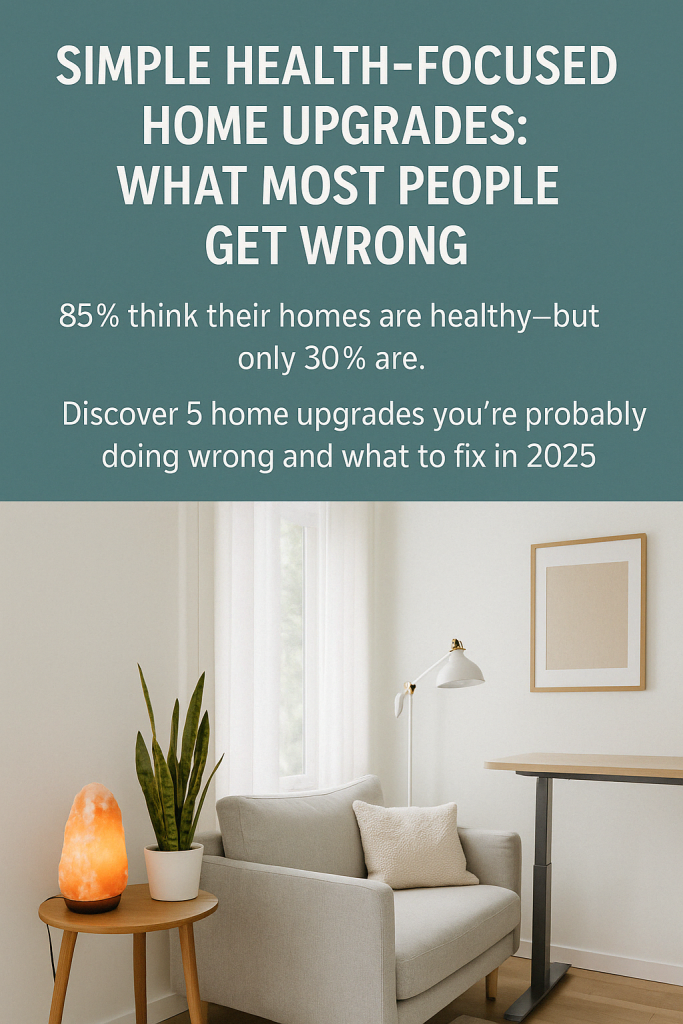🧠 Did You Know?
According to the Global Wellness Institute, 85% of homeowners believe their home is healthy—yet only 30% meet minimum indoor air and toxin safety standards. That’s a huge gap—and that’s exactly where most people get it wrong.
The 2025 wellness trend is shifting from expensive gimmicks to practical, science-backed upgrades that make a real difference. But are you upgrading the right way?
🔍 What Most People Get Wrong About Healthy Home Upgrades
Let’s explore the most common mistakes homeowners make and how to fix them—without breaking the bank.

1. Relying Too Much on Scented Air Fresheners
Many store-bought air fresheners release volatile organic compounds (VOCs) that harm indoor air quality.
✅ Fix it:
- Use essential oil diffusers or natural odor absorbers like baking soda.
- Introduce air-purifying plants like peace lilies or spider plants.
📖 Related tip: The U.S. Environmental Protection Agency (EPA) explains how poor air quality affects health more than you think.
2. Using Trendy But Toxic Materials
Vinyl flooring and synthetic carpets might look great—but they often emit formaldehyde and other harmful gases.
✅ Fix it:
- Choose low-VOC paints, bamboo, cork, or ceramic materials.
- Look for GreenGuard certified products.
3. Ignoring Water Quality
Your water may look clean but contain microplastics, chlorine, or even lead.
✅ Fix it:
- Install a whole-house water filter or a reverse osmosis system.
- Test your water, especially in older homes.
4. Poor Lighting Design
Artificial lighting that’s too bright or too cool can affect your mood, hormones, and sleep.
✅ Fix it:
- Use warm-toned LED bulbs that adjust throughout the day.
- Maximize natural light with mirrors and sheer curtains.
5. Sealing Without Ventilating
A sealed, energy-efficient home can trap indoor pollutants.
✅ Fix it:
- Install ERVs (Energy Recovery Ventilators) or HRVs (Heat Recovery Ventilators).
- Open windows 10 minutes daily for airflow.
📈 2025 Wellness Trends: What to Expect
| Upgrade Idea | Health Benefit | Trend Note |
|---|---|---|
| Salt lamps | Air purification | Trending in sleep-focused households |
| Soundproof wall panels | Mental clarity | Ideal for remote workers |
| EMF-blocking paint | Sleep quality | Popular among biohackers |
| Ergonomic standing desks | Posture & energy | Part of holistic home offices |
| Smart thermostats | Air & humidity control | Key in respiratory health management |
🧠 Pro Tips for Health-Focused Upgrades
- Avoid “greenwashing” by verifying product certifications.
- Don’t just buy gadgets—think of your home as a living wellness ecosystem.
- Start with your bedroom and kitchen—they impact your health the most.
❓ FAQ: Simple Health-Focused Home Upgrades
1. What is the most important health-focused upgrade to start with?
Start with air quality—add HEPA air purifiers and eliminate chemical cleaners.
2. Are smart home devices part of wellness upgrades?
Yes! Devices like smart thermostats and air quality monitors help optimize indoor environments.
3. How do I check if a product is truly eco or health-friendly?
Look for GreenGuard, Energy Star, or EPA Safer Choice certifications.
4. Can wellness upgrades increase my home’s value?
Absolutely. Many buyers prioritize healthy environments, especially post-COVID.
5. Is it expensive to upgrade to non-toxic materials?
Not necessarily. Start small—like switching to low-VOC paint or natural cleaning products.
6. Do indoor plants really clean the air?
Yes—plants like snake plants and English ivy can reduce airborne toxins.
7. How often should I test indoor air or water quality?
Test every 6–12 months, or if you move into a new home.
8. Are EMF-reducing upgrades worth it?
If you’re sensitive to EMF or work around electronics, shielding paint or grounding sheets may help.
9. What rooms should I focus on first?
The bedroom and kitchen are top priorities for wellness-focused upgrades.
💬 Final Words
Small upgrades lead to big changes in your well-being. You don’t have to renovate your whole house—just make intentional, evidence-based choices that align with the 2025 wellness trend.
🛠 Ready to transform your home into a wellness sanctuary—one smart upgrade at a time?

